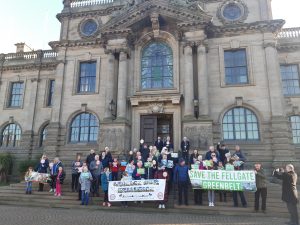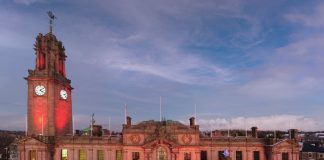A major blueprint for future development in South Tyneside has been rejected for a second time by borough cllrs.
Over a number of years, South Tyneside Council bosses have been working on a local plan for the borough which aims to provide a framework for where new homes, businesses, shops and leisure amenities will be built up until 2040.
It also aims to ensure the right infrastructure, such as roads, health facilities and schools, is in place to support growth.
The local authority has seen several setbacks and amendments to the development blueprint over recent years, including the removal of potential housing sites following public consultation.
Recent changes to the draft development plan saw the percentage of South Tyneside’s Green Belt proposed for development drop from seven per cent to five per cent, as well as a decrease in housing numbers.
However, the plans have also sparked controversy due to proposed housing sites on parts of the Green Belt across South Tyneside, with public opposition to a huge potential housing site of up to 1,200 homes south of Fellgate.
A crunch meeting of South Tyneside Council on 5 September, saw collrs vote by 26 votes to 23, with one abstention, to reject pushing forward with the plan to the final stage, which would have included submitting the plan to the Secretary of State for an independent examination in public.
Concerns raised at the meeting about the local plan included the destruction of trees, green spaces and Green Belt land, the loss of a community centre, an increase in traffic on the roads and a lack of affordable housing.
In recent weeks, a group of 12 Labour cllrs, including the leader of South Tyneside Council Tracey Dixon and deputy council leader Jane Carter, called an extraordinary meeting to re-run the vote on the local plan.
Senior cllrs said this was because of the publication of a new National Planning Policy Framework (NPPF) by the new Labour Government with revised housing targets for councils.
Under the new NPPF, the ‘standard method’ for calculating housing need has changed and the council said this provides a local housing target for South Tyneside of a minimum of 623 homes a year, more than double the 309 units planned for in the current draft local plan.
Under “transitional arrangements”, the council states if the plan was submitted for examination before March 12, 2025, it could progress under the old framework, meaning it would not be required to meet the higher housing need figure.
At a crunch full council meeting this week, cllrs were asked to approve the local plan so that it could be submitted to the Secretary of State for independent examination in public.
Cllr Margaret Meling, the council’s cabinet member for economic growth and transport, previously said that if the current plan is not approved, the council would have to “go back to the drawing board and allocate land for 623 homes a year rather than 309”.
The cllr added this could represent finding “at least 200 hectares of land over and above that already earmarked” and likely increased allocations of Green Belt land for the “additional 5,300 homes that would be needed to accommodate higher housing need.”

At the extraordinary council meeting on 27 February, 2025, a large group of campaigners staged a protest outside South Shields Town Hall ahead of the meeting, and packed inside the council chamber’s public gallery to watch the debate unfold.
Cllrs were told that the local plan had not materially changed since September, 2024, and several opposition cllrs criticised the move to bring the rejected plan back for a second vote.
Several senior Labour cllrs said moving the local plan forward would allow the local authority to maintain control of development in the borough, and to resist speculative development, as well as allowing the plan to progress with a smaller annual housing target.
However, several opposition cllrs reiterated arguments against the local plan made in September, 2024, and criticised the local plan’s sustainability credentials, the level of housing proposed and more.
Some opposition cllrs also suggested the Labour Government would impose higher housing targets on South Tyneside Council in the future, even if the local plan was approved by cllrs.
Cllr Margaret Meling, cabinet member for economic growth and transport, said the local plan demonstrated an “excellent balance” between “environmental, economic and social sustainability”.
The Labour cllr acknowledged the council “may eventually have to accept an increase in our housing targets” but stressed agreeing a local plan before the 12 March, 2025, deadline, would “achieve a breathing space of possibly up to five years.”
Cllr Jim Foreman, Labour cabinet member for housing and community safety, said the council had taken part in several meetings with the “Government intervention team” since the last local plan vote and stressed that failing to vote the plan through on the second attempt would “guarantee intervention”.
He added that the local plan was “robust” and aimed to “try and help the whole of South Tyneside, not just certain elements of residents.”

Cllr Tracey Dixon, Labour council leader, stressed that previous amendments to the local plan had seen dozens of sites removed from development and suggested these sites would have to go back to consultation, along with future sites, under a local plan linked to new housing targets.
Cllr Dixon added that the local plan “does matter to the residents of this borough” and that the council was “trying to get a route to navigate through this for our residents to ensure their voices are heard.”
But cllr David Kennedy, South Tyneside Alliance Group leader, maintained the local plan was “flawed, wrong and that residents don’t want it”, and raised concerns about drainage, flooding and traffic issues.
The independent cllr also suggested the second vote on the local plan was “undemocratic and a waste of resources” and that the national Labour Government would “railroad over whatever goes on today.”
Cllr Paul Brenen, also of the South Tyneside Alliance Group, said the second vote was a “disgraceful attempt” by the council’s Labour Group “to destroy the Green Belt and appease their overlords in Westminster.”
Labour’s Geraldine Kilgour, who previously objected to the plans after raising concerns over developments on Green Belt land in her ward of Fellgate and Hedworth, expressed concerns again about the local plan at Thursday’s extraordinary meeting.

Cllr Kilgour said it was a “very contentious decision to bring the plan back”, noted concerns about the environment, drainage, sewerage capacity and transport links and said that the local plan “isn’t palatable” and that the council needs to “start from scratch”.
Cllr David Francis, Green Group leader on the council, said he still had “serious concerns” about the “unchanged” local plan and that “a better plan was possible and […] still needed.”
Cllr Francis raised concerns about the local plan’s “lack of sufficient commitment to public transport, cycling and active travel routes”, as well as “missing the opportunity to mandate zero carbon homes or sufficiently strong commitments to on-site renewables and energy-efficient housing”.
“It feels like we’re being presented with two options, voting for a plan that we feel is deeply flawed, or stepping into the unknown with possible Government intervention and speculative development,” he added.
“But as Cllr Kennedy said, we know that even where places have a local plan agreed and in place, this Labour Government is forcing additional housing numbers on them.
“So voting for this plan would not be a safeguard against that happening.”
Around 30 South Tyneside cllrs shared their views on the local plan over the two-and-a-half-hour meeting.
After being put to the vote, the local plan was rejected by a majority vote of 27 votes against and 23 votes in support.
The majority of Labour cllrs in attendance voted to support the plan and opposition independent cllrs, Green Party cllrs and Labour’s Cllr Geraldine Kilgour voted against.
Cllrs also voted by a majority to reject the plans being submitted to the Secretary of State for an independent examination in public.
This would have involved a planning inspector assessing the plan over several public hearings, with interested parties able to make representations at the formal meetings.
The planning inspector would then have published a decision on whether the local plan could be formally adopted and the inspector would also have had the power to make modifications and remove specific housing sites.
The vote leaves the council without an up-to-date local plan and a new plan will have to be agreed at some point in the future.
At Thursday’s extraordinary council meeting, it was suggested that the national Government could still potentially “mandate” South Tyneside Council’s local plan to be examined in public by a planning inspector, although it’s understood there’s no precedent for this.
In the meantime, South Tyneside Council will have to begin work on a revised local plan compliant with new planning policy and higher housing targets, with a view of submitting it to the Secretary of State by December,2026.

Cllr Margaret Meling, cabinet member for economic growth and transport, said: “We are naturally very disappointed that the draft plan did not gain approval.
“It has been subject to significant public consultation and is the product of extensive work to compile an evidence base over several years.
“Any revised plan will need to be compliant with the new NPPF, and that means the much higher housing target of at least 623 homes a year.
“We now have an acute housing shortfall which puts us in a much weaker position when it comes to refusing inappropriate development proposals and there is a risk that government could intervene.
“However, our focus must now be to move forward as quickly as possible.”
The Save the Fellgate Green Belt campaign, which has opposed proposals for up to 1,200 homes on one site in the local plan amassing a petition signed by thousands of residents, recently slammed the decision to bring the local plan back before cllrs.
There was also criticism of the extraordinary council meeting being scheduled for 10am during a half-term week and suggestions this could impact the attendance of some cllrs.
A total of 50 of South Tyneside Council’s 54 cllrs voted on the local plan on Thursday, with only three apologies from Labour cllrs announced at the meeting.
Cllr Fay Cunningham, the Mayor of South Tyneside and meeting chair, did not vote on the plan.
Dave Green, a spokesperson for the Save the Fellgate Green Belt campaign group, previously accused the council of trying to “railroad [the local plan] through with scaremongering tactics by saying it will be taken out of their hands”.
Mr Green, who attended the meeting along with campaigners, welcomed cllrs voting the local plan down for a second time.
“We have managed to keep the Green Belt but it’s not all about that, it’s all about the flooding and traffic issues around there and to prevent that for another number of years,” he said.
In a message to campaigners, he added: “Well done everybody for staying positive and staying strong and we got there in the end, so fingers crossed.”
In a statement released after the extraordinary council meeting, South Tyneside Council’s Green Group added the decision taken was not an “end point” and could be seen as a “springboard to a more progressive plan”.
Cllr Shirley Ford, the Green Group’s deputy leader, said: “A bad plan guarantees injustice. Instead, Thursday’s vote is a beginning.
“It is a rejection of the undemocratic silencing of the genuine concerns of the residents of South Tyneside.
“A vote against this plan opens a new space and opportunity for the council to show that it can listen rather than ignore.”
The full council meeting was broadcast on South Tyneside Council’s YouTube channel.




